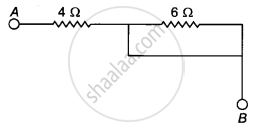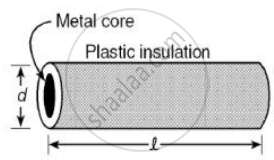Advertisements
Advertisements
प्रश्न
On what factors does the resistance of a conductor depend?
List the factors on which the resistance of a uniform cylindrical conductor of a given material depends.
List two factors on which the resistance of a rectangular conductor depends.
उत्तर
Factors on which the resistance of a conductor depends:
- Length of conductor: Resistance is directly proportional to the length of the conductor. This means Resistance increases with an increase in the length of the conductor. This is the cause that long electric wires create more resistance to the electric current.
- Area of cross-section: Resistance is inversely proportional to the area of the cross-section of the conductor. This means Resistance will decrease with an increase in the area of the conductor and vice versa. This is the cause that thick copper wire creates less resistance to the electric current.
- Temperature: Resistance is directly proportional to the temperature.
- Nature of material: Some materials create the least hindrance and hence are called good conductors. Silver is the best conductor of electricity. While some other materials create more hindrance in the flow of electric current, i.e. flow of electrons through them. Such materials are called bad conductors. Bad conductors are also known as insulators. The hard plastic is one of the best insulators of electricity.
APPEARS IN
संबंधित प्रश्न
Use the data in the Table given below to answer the following –
Which among iron and mercury is a better conductor?
Table give below Electrical resistivity of some substances at 20°C
| Electrical resistivity of some substances at 20°C | ||
| − | Material | Resistivity (Ω m) |
| Conductors |
Silver | 1.60 × 10−8 |
| Copper | 1.62 × 10−8 | |
| Aluminium | 2.63 × 10−8 | |
| Tungsten | 5.20 × 10−8 | |
| Nickel | 6.84 × 10−8 | |
| Iron | 10.0 × 10−8 | |
| Chromium | 12.9 × 10−8 | |
| Mercury | 94.0 × 10−8 | |
| Manganese | 1.84 × 10−6 | |
| Alloys |
Constantan (alloy of Cu and Ni) |
49 × 10−6 |
| Manganin (alloy of Cu, Mn and Ni) |
44 × 10−6 | |
| Nichrome (alloy of Ni, Cr, Mn and Fe) |
100 × 10−6 | |
| Insulators | Glass | 1010 − 1014 |
| Hard rubber | 1013 − 1016 | |
| Ebonite | 1015 − 1017 | |
| Diamond | 1012 − 1013 | |
| Paper (dry) | 1012 | |
A copper wire has diameter 0.5 mm and resistivity of 1.6 × 10−8Ω m. What will be the length of this wire to make its resistance 10 Ω? How much does the resistance change if the diameter is doubled?
Why are copper and aluminium wires usually employed for electricity transmission?
Why are alloys commonly used in electrical heating devices? Give reason.
Fill in the following blanks with suitable words:
Copper is a good .......... Plastic is an ..........
Which has less electrical resistance : a thin wire or a thick wire (of the same length and same material)?
What happens to the resistance as the conductor is made thinner?
Name the electrical property of a material whose symbol is "omega".
What happens to the resistance as the conductor is made thicker?
Which among iron and mercury is a better conductor of electricity?
What do you understand by the "resistivity" of a substance?
How does the resistance of a conductor depend on:
temperature of the conductor?
What would be the effect on the resistance of a metal wire of:
increasing its length?
What would be the effect on the resistance of a metal wire of:
increasing its diameter?
How does the resistance of a wire change when:
its material is changed to one whose resistivity is three times?
Write the relation between resistance and electrical resistivity of the material of a conductor in the shape of a cylinder of length `'l'` and area of cross-section `'A'` . Hence derive the S.I. unit of electrical resistivity.
Materials which allow larger currents to flow through them are called:
The element used almost exclusively for filaments of incandescent lamps:
The effective resistance between A and B is:

A cylindrical conductor of length l and uniform area of cross-section A has resistance R. Another conductor of length 2l and resistance R of the same material has an area of cross-section:

Plastic insulation surrounds a wire having diameter d and length l as shown above. A decrease in the resistance of the wire would be produced by an increase in the ______.
The resistance of a wire of 0.01 cm radius is 10 Ω. If the resistivity of the wire is 50 × 10-8 Ω, find the length of this wire.
How will the resistance of a wire be affected if its
- length is doubled, and
- radius is also doubled ?
Give justification for your answer.
